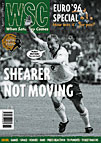 David Wangerin explains why Euro '96 at Villa Park was a dazzling experience in the stands as much as on the pitch
David Wangerin explains why Euro '96 at Villa Park was a dazzling experience in the stands as much as on the pitch
It was fun, it was interesting, and it was orange. Dutch orange. What Birmingham’s inhabitants are likely to remember most vividly about their city’s participation in Euro ’96 is the number of visitors who came to town wearing tangerine. If not a replica kit (from any era), then a T-shirt, or overalls, or a big hat, or spray-painted clogs. The Dutch must have the most conspicuous fans on earth.
A good thing, then, that they shared a group with Scotland, for the scenes outside the Aston pubs before the second match of Group A would have heartened even the most fearful of local residents. Navy blue stood next to orange – and you couldn’t be sure who supported whom. The presence of 450 police officers standing around with seemingly nothing to do, and the sight of bemused local merchants openly grinning outside their shops, wasn’t something normally associated with matchdays at Villa Park.
Inside the ground the atmosphere was equally as convivial. When the recording of their national anthem failed after a few bars, Dutch fans carried on with an impromptu a cappella version – and were rewarded with a hearty Scottish cheer from the Holte End. (The Dutch anthem failure, it must be said, wasn’t the only glitch at Villa Park. There wasn’t any sort of scoreboard, and the sound system was rather embarrassing. But why rain on the parade? It’s not every day Villa Park stewards are confronted with an accordion-bearing fan. Would that the Euro ’96 bass drums, trumpets, and large flags be allowed into the ground during the domestic season.)
Birmingham, a city keen to be regarded as cosmopolitan, took to the international flavour of Euro ’96 with unabashed enthusiasm – particularly once it was discovered the Dutch, Swiss, and Scottish supporters hadn’t come to town just to make the local constabulary’s life miserable. Local media seemed only too happy to act as PR agents; it was made abundantly clear how happy the police were with fan behaviour, pictures of the more eccentric supporters featuring with some monotony.
Certainly the Dutch woman who sat next to me for the Switzerland match deserved a prize for the hat she somehow managed to keep on her head the entire 90 minutes without injuring her spinal column.
The Scots, as you might expect, provided their team with ample support – and unlike the Dutch they didn’t need help from a small brass band that played all its music in the same key. For me, hearing 30,000 sing ‘Flower of Scotland’ at the top of their voices was one of the most memorable parts of the tournament. That, and the spontaneous cheering at seemingly random intervals during Scotland v Switzerland.
So many fans turned up with radios that, as England began piling on the goals at Wembley, virtually the entire ground developed a keen interest in the goal margin. When people say watching a match on television doesn’t hold a candle to being there, this is what they have in mind.
Sadly, the match that should have provided the most excitement – the Portugal v Czech Republic quarter-final – probably supplied the least. The Czech fans did their best to get behind their team, even if their support was limited to one monotonous chant, and the Portuguese waved lots of flags. But the cautious approach both sides took, combined with some embarrassing officiating, took much of the enjoyment away.
For those of us who weren’t following any team in particular, Euro ’96 was a disappointment in footballing terms: few exceptional goals, no pulsa-ting come-from-behind matches, and tactics which owed more to the fear of losing than the determination to win. In Birmingham, as elsewhere, what made the tournament a success were the fans. And if it meant letting a few Birmingham, West Brom or Wolves supporters into my team’s ground, that was okay by me.
From WSC 114 August 1996. What was happening this month